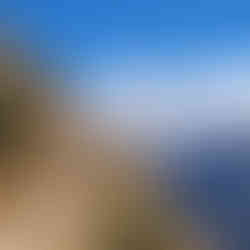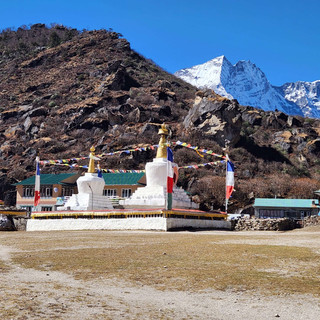Nepal Chapter 1
- Caitlyn Milton
- Oct 30, 2022
- 6 min read
Updated: Dec 25, 2022
Kathmandu to Namche

Upon arrival
The thing with traveling is that things seldom go according to plan. Planning beyond 50% of the way is usually an exercise in futility.
My first day in Nepal was no exception.
After landing, I set out to book a regional hopper flight from Kathmandu to Lukla, where I would officially begin the 110-mile Three Passes Loop trek.
What I didn't realize was that I arrived in the middle of the annual five-day Tahir Festival, which meant the country was bustling and domestic flights were booked up for days.
Because there are no roads to Lukla, my only options were taking a five hour bus ride to another town where I could then catch a flight into Lukla, or hike in. I'd just spent over twenty hours sitting on airplanes, so the bus ride sounded super unappealing, and I didn't have an extra week to spend hiking the extra miles.
But as such, the universe has a way of providing what you need, when you need it and in a way you could never have planned for.
Up and over
While trying to solve this dilemma, I met someone who connected me with someone who all but escorted me right onto the tarmac and into a helicopter.
That's right; for slightly more rupees than a one-way airplane ticket, I got to hop a quick forty minutes directly into Lukla via helicopter!
My two flight companions were Mike, from Australia, and Matija, from Croatia. Mike and Matija were headed to Lukla to begin an adventure mountaineering up the majestic Mt. Ama Dablam.

Because we were short one person from having a full helicopter, they decided it would be a passenger + cargo flight. And that day's cargo was cases of Everest beer. With my backpack squeezed on one side of the boxes and me on the other, we loaded in and took off.

What a truly incredible introduction to the Himalayas! Zipping through narrow valleys and above wide open saddles was truly breathtaking.

My first teahouse: Lukla
Since we arrived in the late afternoon, I decided to stay the night in Lukla. Mike and Matija met up with their guide and porter and forged ahead into the night.

I stayed in a teahouse and had a traditional garlicky veggie soup and a fried egg for dinner. About twelve hours ahead of my home timezone, I had dinner by 4:00p, was asleep by 5:00p and wide awake again by 12:30a.
As an unintended consequence to trying to stay hydrated, I found myself having to vacate my cozy sleeping bag at around 1:00a to go outside with my headlamp and use the squat toilet.
Later I (re)awoke to the sounds of roosters crowing, dogs barking and cows mooing. With a belly full of hot porridge and another fried egg, I began my trek toward Monjo.
Day 1 trekking
Upon leaving Lukla, all trekkers are obligated to stop and register with the Nepalese government. They scan your passport, ask where you're going and hand you an electronic card that you have to scan at various checkpoints along the way.
The trek north from Lukla largely follows the beautiful Dudh Koshi river. Born from Himilayan glacier water, it has a milky turquoise blue-hue that reminded me of the glacial lakes and rivers of Banff, Jasper and Glacier National Parks.
Because Lukla has an airport and is relatively close to Kathmandu, the route north from town acts as a main artery connecting many (hundreds!?!) Nepalese villages. The footing is a mix of dirt, natural rocks and laid stone, and cuts right through the center of most villages.
It winds up and down and crisscrosses the river by way of narrow cable bridges.
Utterly impassable by vehicles, it is instead a thoroughfare of Bhutani pony and yak caravans, and porters carrying life's essentials to those living deep in the Himilayas (and removing the discards, such as empty water, cooking oil and fuel canisters).
The route is also paved in manure.
When in Rome...
My goal is to get an as-authentic-as-possible experience while here, which includes eating like a local. Food-wise, this means eating a lot of Dal Bhat.

Dal bhat is usually a few different kinds of curried and/or fermented vegetables, lentil soup and white rice (with free refills galore!), and my first time trying it was at the second night's teahouse, in Monjo. It was delicious!
This was the second night as the sole guest at my teahouse.
In the morning, I had traditional Nepalese bread topped with fried eggs for breakfast. Sensing a theme...? Ha

Trekking day 2
The trek from Monjo to Namche was relatively short but steep, with nearly 2,000f elevation gain.
I learned that at altitude, a twenty five-pound backpack feels more like fifty.
At one point, I looked up only to realize I was pacing at the same rate as an elderly man carrying at least a hundred pounds and wearing the equivalent of Crocs--without socks.
It sure was beautiful though!
Acclimating in Namche
This village is bigger than I expected, and after dropping my backpack off at a hotel, I switched to my small daypack and headed up for an acclimatization hike.
A common misconception about acclimating is that you should just hang out for a while as you gain in altitude. The correct way to acclimate, however, is to do a series of hikes that take you higher, before descending again.
For example, I climbed about 2,000f from Monjo to Namche. While in Namche I did a couple hikes that took me up an additional 1,300f or so before descending back to Namche to sleep at night.
This gives the body time to grow accustomed without putting it through too much strain. Climbing in altitude too quickly—especially under physically demanding circumstances—can cause Acute Altitude Sickness (also known as Acute Mountain Sickness). And that's no good.
On my first day hike in Namche, I ran into none other than Mike and Matije, who were also taking the day to acclimate! We ended up meeting again that evening for dessert, which was a lot of fun.
Brad the mountaineer
While eating dinner at my hotel that night, I met another guest, named Brad. Brad is tall, with tanned cheeks, dusty blonde hair and blue eyes. Funny enough, he was born and raised in Boulder.
Brad is a mountaineer.
The real kind. The kind that's steeped in history and tradition--and relies on a gut instinct that can only properly be honed patiently, over decades of experience.
He has been to Nepal over a dozen times and through that, developed relationships with the place and its people, including the family who owns the hotel and a few unsung heros: sherpas.
When I got back from dessert with Mike and Matija, I noticed Brad and a few others were still in the dining room (which is also where the toasty woodburning stove is) so I ducked back in to say hi and warm up.
He was drinking a homemade rice beer, called chhaang, with his sherpa and the owner of the hotel.
I declined it at first, but ended up with not one—but two—shots of chhaang while talking about mountaineering and how much the villages throughout the Khumbu Valley have changed.
An ode to sherpas
That's when he told me about his sherpa (I'm kicking myself for not remembering or writing down his name). If I recall correctly, he has summited most of the world's highest peaks. Not only has he summited Everest something like twenty times, he also helped lay the ropes that hundreds (thousands?) of climbers rely on.
And there he was, right across from me.
It launched us into a conversation about the people who make mountaineering possible--and safer—for everyone.
Laying ropes is one thing, but sherpas are also highly skilled mountaineers who use their intimate knowledge of the mountains, glaciers, snow and weather to make judgement calls in the best interest of their clients.
In addition, they carry (very heavy) critical gear up and down the mountains.
They don't get nearly enough credit or visibility.
All five senses
For the second hike, I did a longer loop that took me through the villages of Kunde and Khumjung.

Something I'm trying to be more mindful about is experiencing things using all five senses. For me, I often forget about the importance of touch.
So... at the entrance to Kunde, there was a wall of prayer wheels. There must have been over fifty.


Upon entering, I admired the colorful paintings and proceeded to spin the prayer wheels. All of them.
I'm hoping this did more to pay homage to an ancient tradition than the equivalent of pressing all the buttons in an elevator.

I attempted to visit a monastery there but it was all locked up.
Rounding back down into town, the trail took me through a dense forest of cedar and juniper trees. It was intensely fragrant! I literally stopped and put my nose right up to a tree trunk.
Smell has me thinking about food. Tonight I'm eating an early dinner of more Dal Bhat and going to bed early, probably once again to the faint smell of the manure that's forevermore embedded in the tread of my boots... and will likely be awoken by the smell of smoke coming from the teahouse's wood-burning stove being stoked back to life in time for breakfast.
Tomorrow I make the long slow trek toward Thame, where I'll stay two nights and do another day hike, taking me to the highest elevation I've ever climbed to before.





















































I am really glad you are a documenting this. It's pretty amazing to see some of the sites that you were capturing through videos and photo.
Wow!! Just Wow!-jlh